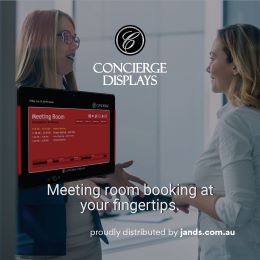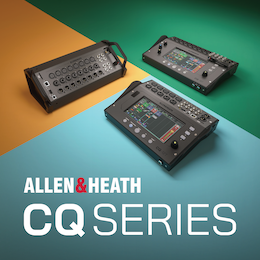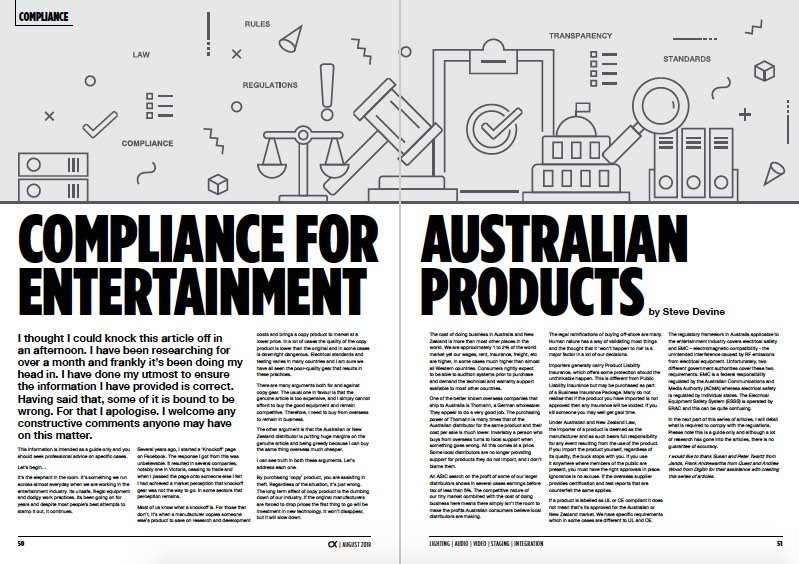Subscribe to CX E-News
Features – Compliance
Compliance for Australian Entertainment Products
By Steve Devine.
I thought I could knock this article off in an afternoon. I have been researching for over a month and frankly it’s been doing my head in. I have done my utmost to ensure the information I have provided is correct. Having said that, some of it is bound to be wrong. For that I apologise. I welcome any constructive comments anyone may have on this matter.
This information is intended as a guide only and you should seek professional advice on specific cases.
Let’s begin…
It’s the elephant in the room. It’s something we run across almost everyday when we are working in the entertainment industry. Its unsafe, illegal equipment and dodgy work practices. Its been going on for years and despite most people’s best attempts to stamp it out, it continues.
Several years ago, I started a ‘Knockoff’ page on Facebook. The response I got from this was unbelievable. It resulted in several companies, notably one in Victoria, ceasing to trade and when I passed the page onto someone else I felt I had achieved a market perception that knockoff gear was not the way to go. In some sectors that perception remains.
Most of us know what a knockoff is. For those that don’t, it’s when a manufacturer copies someone else’s product to save on research and development costs and brings a copy product to market at a lower price.
In a lot of cases the quality of the copy product is lower than the original and in some cases is downright dangerous. Electrical standards and testing varies in many countries and I am sure we have all seen the poor-quality gear that results in these practices.
There are many arguments both for and against copy gear. The usual one in favour is that the genuine article is too expensive, and I simply cannot afford to buy the good equipment and remain competitive. Therefore, I need to buy from overseas to remain in business.
The other argument is that the Australian or New Zealand distributor is putting huge margins on the genuine article and being greedy because I can buy the same thing overseas much cheaper.
I can see truth in both these arguments. Let’s address each one.
 By purchasing ‘copy’ product, you are assisting in theft. Regardless of the situation, it’s just wrong. The long term affect of copy product is the dumbing down of our industry. If the original manufacturers are forced to drop prices the first thing to go will be investment in new technology. It won’t disappear, but it will slow down.
By purchasing ‘copy’ product, you are assisting in theft. Regardless of the situation, it’s just wrong. The long term affect of copy product is the dumbing down of our industry. If the original manufacturers are forced to drop prices the first thing to go will be investment in new technology. It won’t disappear, but it will slow down.
The cost of doing business in Australia and New Zealand is more than most other places in the world. We are approximately 1 to 2% of the world market yet our wages, rent, insurance, freight, etc are higher, in some cases much higher than almost all Western countries.
Consumers rightly expect to be able to audition systems prior to purchase and demand the technical and warranty support available to most other countries. One of the better known overseas companies that ship to Australia is Thomann, a German wholesaler. They appear to do a very good job. The purchasing power of Thomann is many times that of the Australian distributor for the same product and their cost per sale is much lower.
Invariably a person who buys from overseas turns to local support when something goes wrong. All this comes at a price. Some local distributors are no longer providing support for products they do not import, and I don’t blame them.
An ASIC search on the profit of some of our larger distributors shows in several cases earnings before tax of less than 5%. The competitive nature of our tiny market combined with the cost of doing business here means there simply isn’t the room to make the profits Australian consumers believe local distributors are making.
The legal ramifications of buying off-shore are many. Human nature has a way of validating most things and the thought that it ‘won’t happen to me’ is a major factor in a lot of our decisions.
Importers generally carry Product Liability Insurance, which offers some protection should the unthinkable happen. This is different from Public Liability Insurance but may be purchased as part of a Business Insurance Package. Many do not realise that if the product you have imported is not approved then any insurance will be voided.
If you kill someone you may well get gaol time.
Under Australian and New Zealand Law, the importer of a product is deemed as the manufacturer and as such bears full responsibility for any event resulting from the use of the product. If you import the product yourself, regardless of its quality, the buck stops with you.
If you use it anywhere where members of the public are present, you must have the right approvals in place. Ignorance is no excuse. If the overseas supplier provides certification and test reports that are counterfeit the same applies. If a product is labelled as UL or CE compliant it does not mean that’s its approved for the Australian or New Zealand market. We have specific requirements which in some cases are different to UL and CE.
The regulatory framework in Australia applicable to the entertainment industry covers electrical safety and EMC – electromagnetic compatibility – the unintended interference caused by RF emissions from electrical equipment. Unfortunately, two different government authorities cover these two requirements.
EMC is a federal responsibility regulated by the Australian Communications and Media Authority (ACMA) whereas electrical safety is regulated by individual states. The Electrical Equipment Safety System (ESSS) is operated by ERAC and this can be quite confusing.
In the next part of this series of articles, I will detail what is required to comply with the regulations. Please note this is a guide only and although a lot of research has gone into the articles, there is no guarantee of accuracy.
I would like to thank Susan and Peter Twartz from Jands, Frank Andrewartha from Quest and Andrew Wood from Digilin for their assistance with creating this series of articles.
Read ‘Compliance Part Two. EMC: Electromagnetic Compatibility’ – here
This article first appeared in the print edition of CX Magazine August 2018 pp.50-51. CX Magazine is Australia and New Zealand’s only publication dedicated to entertainment technology news and issues. Read all editions for free or search our archive www.cxnetwork.com.au
© CX Media
Read the Set:
Part One – Compliance for Australian Entertainment Products (Aug 2018)
Part Two – EMC: Electromagnetic Compatibility (Sept 2018)
Part Three – Electrical Safety (Oct 2018)
UPDATE – ACETA Solves the Compliance Issue (CX Dec-Jan 2018)
Subscribe
Published monthly since 1991, our famous AV industry magazine is free for download or pay for print. Subscribers also receive CX News, our free weekly email with the latest industry news and jobs.













